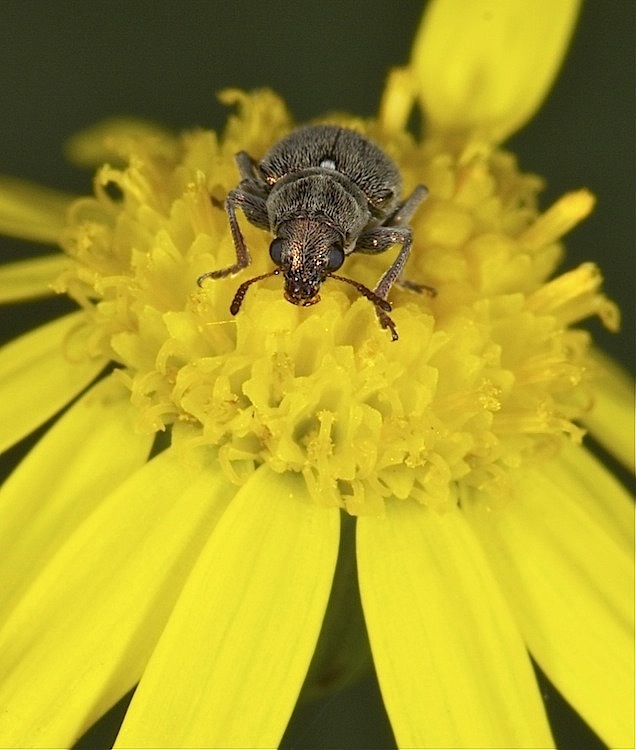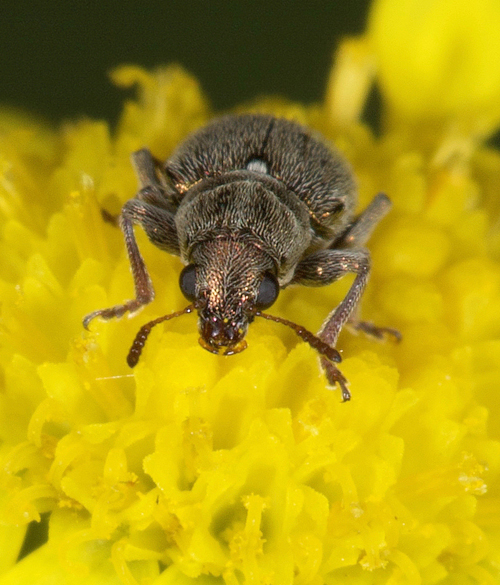Zigzag Fruit Chafer Anisorrhina (Anisorrhina) flavomaculata flavomaculata
Family Scarabaeidae. Subfamily Cetoniinae. Tribe Goliathini
Garden in Gauteng © Alf
Identification
Size: 15-25 mm.
Elytra tricolor, reddish-brown with yellow markings outlined in black. Pronotum with 4 black spots. Scutellum with 2 black spots.
Biology
The adult beetles feed on various overripe fruits, flowers and sap flow from wounds in trees. This species also raids hives. Larvae feed on dung or compost.
Distribution
The species is distributed throughout South Africa.
AW Insect Book: Beetles - Coleoptera
Moderator: Klipspringer
-
Klipspringer
- Global Moderator
- Posts: 5858
- Joined: Sat Sep 14, 2013 12:34 pm
- Country: Germany
- Contact:
-
Klipspringer
- Global Moderator
- Posts: 5858
- Joined: Sat Sep 14, 2013 12:34 pm
- Country: Germany
- Contact:
Re: AW Insect Book: Beetles - Photos & Descriptions
Celtis Leaf Beetle Megaleruca sp.
Family Chrysomelidae. Subfamily Galerucinae. Tribe Galerucini
Nelspruit © Richprins
Identification
Small to medium-sized (3-10 mm), oblong, matt brownish or lead grey to yellowish leaf beetles. Pronotum and head have dark markings. The antennae are thin thread-like, thickening a little towrds apex, slightly over half as long as the body. Pronotum is much wider than long, rounded to hexagonal, slightly narrower than the evenly broad elytra.
Very pale individuals may be tenerals, recently emerged from the pupae and will darken in colour in a matter of hours.
The genus needs revision.
Biology
Both the larvae and the adults are herbivores, on shrubs and trees in the genus Celtis .
Rough, blackish pupae form dense clusters on trunks and branches (and sometimes leaves) of the host tree.
Distribution
The genus is widespread in Africa.
Family Chrysomelidae. Subfamily Galerucinae. Tribe Galerucini
Nelspruit © Richprins
Identification
Small to medium-sized (3-10 mm), oblong, matt brownish or lead grey to yellowish leaf beetles. Pronotum and head have dark markings. The antennae are thin thread-like, thickening a little towrds apex, slightly over half as long as the body. Pronotum is much wider than long, rounded to hexagonal, slightly narrower than the evenly broad elytra.
Very pale individuals may be tenerals, recently emerged from the pupae and will darken in colour in a matter of hours.
The genus needs revision.
Biology
Both the larvae and the adults are herbivores, on shrubs and trees in the genus Celtis .
Rough, blackish pupae form dense clusters on trunks and branches (and sometimes leaves) of the host tree.
Distribution
The genus is widespread in Africa.
Re: AW Insect Book: Beetles - Coleoptera
Hairy Leaf Beetle Macrocoma (Chapuis 1874) sp. or Pseudocolaspis (Laporte 1833) sp.*
Family Chrysomelidae. Subfamily Eumolpinae (oval leaf beetles). Tribe Bromiini (Adoxini)


Imfolozi (*poss. ID by Stefano Zoia of African Eumolpinae (Coleoptera Chrysomelidae) website:( “…it could be either one of the small Macrocoma or Pseudocolaspis taxa or even a new taxon,…” pers. comm.)
Subfamily Eumolpinae
Eumolpinae is a large subfamily of Chrysomelidae. It includes more than 500 genera and 7000 species. More eumolpine species are being discovered and described every year. Chaboo (2007), in her recent monograph on Cassidinae, shows Eumolpinae as third in species diversity after Galerucinae and Cassidinae.
Eumolpinae are widely distributed. They are numerous in the tropics and subtropics. Many Eumolpinae remain to be described and recorded, particularly in tropical Africa, tropical America, and the Pacific Basin including Sunda Islands, New Guinea, and New Caledonia.
They are commonest in tropical forest and on trees and shrubs in the more thickly wooded savannas. Thus they are often serious pests of plantation crops, e.g. coffee, cocoa, tea and cotton. All the larvae found up to the present time are root feeders.
Tribe Bromiini (Adoxini):
This tribe comprises several strongly divergent or convergent groups having the following characters:
- prothorax cylindrical or sub-cylindrical and frequently lacking a margin
- usually heavily pubescent, the setae often broadened and scale-like.
Genus Macrocoma
Macrocoma is closely related to the African genus Pseudocolaspis, and has sometimes been treated as a junior synonym of it historically. It contains about 100 species, which are found in tropical Africa, around the Mediterranian, on the Canary Islands, in western and central Asia, and in India.
Diagnosis after Selman (1965):
Pygidium covered by the elytra, scutellum cordiform, not bi- or tri-cuspid, anterior edge of the lateral arms of the prosternum flat, elytra long and slender. General appearance usually setose, femur never armed with more than one ventral tooth, middle tibiae shorter than the anterior tibiae, elytra and pronotum smooth and not strongly sculptured, elytra only gradually narrowing distally and never with longitudinal costae, usually covered in a dense mass of silvery scale-like setae, pronotum often with the sides tapering anteriorly, with the anterior end shorter than the posterior end.
Recorded from South Africa:
Macrocoma aureovillosa (Marshall, 1865)
Macrocoma bipilosa (Schaufuss, 1871)
Macrocoma eriophora Chapuis, 1874
Macrocoma haliporphyrea (Marshall, 1865)
Macrocoma oneili (Jacoby, 1904)
Genus Pseudocolaspis
Pseudocolaspis contains about 80 species, which are found in tropical Africa.
Diagnosis after Selman (1965): Pygidium more than half exposed, scutellum usually bi- or tri-cuspid, anterior edge of the lateral arms of the prosternum convex, though in many of the smaller species the convexity is lost or almost lost, elytra short, pronotum globose with the sides evenly curved, body setose, the density of the setae variable, setae usually scale-like, femur never with more than one ventral tooth.
Recorded from South Africa:
Pseudocolaspis brachiata Lefèvre, 1890
Pseudocolaspis femorata Baly, 1878
Pseudocolaspis gracilipes Lefèvre, 1890
Pseudocolaspis hottentotta Lefèvre, 1890
Pseudocolaspis lateralis Jacoby, 1898
Pseudocolaspis laticollis Jacoby, 1898
Pseudocolaspis obscura Schaufuss, 1871 (?, species inquirenda)
Pseudocolaspis semipurpurea Marshall, 1865
Pseudocolaspis sericata Marshall, 1865
Pseudocolaspis servula Marshall, 1865
Pseudocolaspis tibialis Schaufuss, 1871
Pseudocolaspis variegata Lefèvre, 1890
Pseudocolaspis viridana Lefèvre, 1890
Identification
“To divide Macrocoma from Pseudocolaspis is not always easy and maybe a real difference does not exist, as already assumed by a few authors in the past; moreover a revision of all described taxa does not exist and I am nearly sure that several “Macrocoma" are still ranged in “Pseudocolaspis" and vice versa. “ Stefano Zoia*
https://ia800203.us.archive.org/12/item ... -86049.pdf
http://www.bio-nica.info/biblioteca/Jol ... lpinae.pdf
http://www.chrysomelidae.it/afr_Eum/che ... frica.html
*http://www.chrysomelidae.it/afr_Eum/pagina2.html (African Eumolpinae (Coleoptera Chrysomelidae) website
Family Chrysomelidae. Subfamily Eumolpinae (oval leaf beetles). Tribe Bromiini (Adoxini)


Imfolozi (*poss. ID by Stefano Zoia of African Eumolpinae (Coleoptera Chrysomelidae) website:( “…it could be either one of the small Macrocoma or Pseudocolaspis taxa or even a new taxon,…” pers. comm.)
Subfamily Eumolpinae
Eumolpinae is a large subfamily of Chrysomelidae. It includes more than 500 genera and 7000 species. More eumolpine species are being discovered and described every year. Chaboo (2007), in her recent monograph on Cassidinae, shows Eumolpinae as third in species diversity after Galerucinae and Cassidinae.
Eumolpinae are widely distributed. They are numerous in the tropics and subtropics. Many Eumolpinae remain to be described and recorded, particularly in tropical Africa, tropical America, and the Pacific Basin including Sunda Islands, New Guinea, and New Caledonia.
They are commonest in tropical forest and on trees and shrubs in the more thickly wooded savannas. Thus they are often serious pests of plantation crops, e.g. coffee, cocoa, tea and cotton. All the larvae found up to the present time are root feeders.
Tribe Bromiini (Adoxini):
This tribe comprises several strongly divergent or convergent groups having the following characters:
- prothorax cylindrical or sub-cylindrical and frequently lacking a margin
- usually heavily pubescent, the setae often broadened and scale-like.
Genus Macrocoma
Macrocoma is closely related to the African genus Pseudocolaspis, and has sometimes been treated as a junior synonym of it historically. It contains about 100 species, which are found in tropical Africa, around the Mediterranian, on the Canary Islands, in western and central Asia, and in India.
Diagnosis after Selman (1965):
Pygidium covered by the elytra, scutellum cordiform, not bi- or tri-cuspid, anterior edge of the lateral arms of the prosternum flat, elytra long and slender. General appearance usually setose, femur never armed with more than one ventral tooth, middle tibiae shorter than the anterior tibiae, elytra and pronotum smooth and not strongly sculptured, elytra only gradually narrowing distally and never with longitudinal costae, usually covered in a dense mass of silvery scale-like setae, pronotum often with the sides tapering anteriorly, with the anterior end shorter than the posterior end.
Recorded from South Africa:
Macrocoma aureovillosa (Marshall, 1865)
Macrocoma bipilosa (Schaufuss, 1871)
Macrocoma eriophora Chapuis, 1874
Macrocoma haliporphyrea (Marshall, 1865)
Macrocoma oneili (Jacoby, 1904)
Genus Pseudocolaspis
Pseudocolaspis contains about 80 species, which are found in tropical Africa.
Diagnosis after Selman (1965): Pygidium more than half exposed, scutellum usually bi- or tri-cuspid, anterior edge of the lateral arms of the prosternum convex, though in many of the smaller species the convexity is lost or almost lost, elytra short, pronotum globose with the sides evenly curved, body setose, the density of the setae variable, setae usually scale-like, femur never with more than one ventral tooth.
Recorded from South Africa:
Pseudocolaspis brachiata Lefèvre, 1890
Pseudocolaspis femorata Baly, 1878
Pseudocolaspis gracilipes Lefèvre, 1890
Pseudocolaspis hottentotta Lefèvre, 1890
Pseudocolaspis lateralis Jacoby, 1898
Pseudocolaspis laticollis Jacoby, 1898
Pseudocolaspis obscura Schaufuss, 1871 (?, species inquirenda)
Pseudocolaspis semipurpurea Marshall, 1865
Pseudocolaspis sericata Marshall, 1865
Pseudocolaspis servula Marshall, 1865
Pseudocolaspis tibialis Schaufuss, 1871
Pseudocolaspis variegata Lefèvre, 1890
Pseudocolaspis viridana Lefèvre, 1890
Identification
“To divide Macrocoma from Pseudocolaspis is not always easy and maybe a real difference does not exist, as already assumed by a few authors in the past; moreover a revision of all described taxa does not exist and I am nearly sure that several “Macrocoma" are still ranged in “Pseudocolaspis" and vice versa. “ Stefano Zoia*
https://ia800203.us.archive.org/12/item ... -86049.pdf
http://www.bio-nica.info/biblioteca/Jol ... lpinae.pdf
http://www.chrysomelidae.it/afr_Eum/che ... frica.html
*http://www.chrysomelidae.it/afr_Eum/pagina2.html (African Eumolpinae (Coleoptera Chrysomelidae) website


